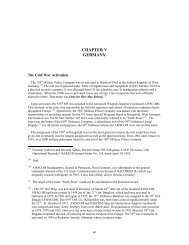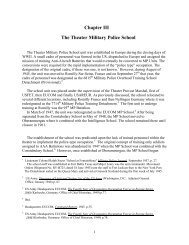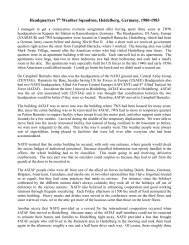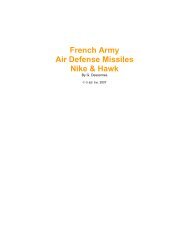The Theater Military Police School - USAREUR Main Page
The Theater Military Police School - USAREUR Main Page
The Theater Military Police School - USAREUR Main Page
You also want an ePaper? Increase the reach of your titles
YUMPU automatically turns print PDFs into web optimized ePapers that Google loves.
<strong>The</strong> <strong>The</strong>ater <strong>Military</strong> <strong>Police</strong> <strong>School</strong><br />
<strong>The</strong> <strong>The</strong>ater <strong>Military</strong> <strong>Police</strong> <strong>School</strong> unit was established in Europe during the closing days of<br />
WWII. A small cadre of personnel was formed in the US, dispatched to Europe and assigned the<br />
mission of training Anti-Aircraft Batteries that would eventually be converted to MP Units. <strong>The</strong><br />
conversions were required for the rapid implementation of the “police type” occupation. <strong>The</strong><br />
designation of the original cadre, if there was one, is not known. However, during August of<br />
1945, the unit was moved to Romilly-Sur-Seine, France and on September 27 th that year, the<br />
cadre of personnel was designated as the 6815 th <strong>Military</strong> <strong>Police</strong> Overhead Training <strong>School</strong><br />
Detachment (Provisional). 1<br />
<strong>The</strong> school unit was placed under the supervision of the <strong>The</strong>ater Provost Marshal, first of<br />
USFET, then EUCOM and finally <strong>USAREUR</strong>. As previously discussed, the school relocated to<br />
several different locations throughout Germany, including Nellingen where it was redesignated<br />
as the 7714 th <strong>Military</strong> <strong>Police</strong> Training Detachment. 2 In March of 1947, the unit was again<br />
redesignated as the EUCOM MP <strong>School</strong>. 3 After being separated from the Constabulary <strong>School</strong> in<br />
May of 1948, the MP <strong>School</strong> moved to Oberammergau where it combined with the Intelligence<br />
<strong>School</strong>. <strong>The</strong> school remained there until closure in 1961.<br />
<strong>The</strong> establishment of the school was predicated upon the lack of trained personnel within the<br />
theater to implement the police-type occupation. 4 <strong>The</strong> original concept of training only soldiers<br />
assigned to AAA Battalions was abandoned in 1947 when the MP <strong>School</strong> was combined with the<br />
Constabulary <strong>School</strong>. 5 However, once established at Oberammergau, the MP <strong>School</strong> began<br />
accepting and training two (2) types of in-theater personnel. 6 One type was the soldier who<br />
desired to change his <strong>Military</strong> Occupation Specialty (MOS) to become an MP’s. <strong>The</strong> other type<br />
1<br />
US Army, Directory of Units and Station List of the US Army (Washington, D.C.: Adjutant General<br />
Office, January 1946) p. 87.<br />
2 US Army Headquarters EUCOM, <strong>The</strong> Fourth Year of Occupation-Occupation Forces in Europe Series,<br />
1948 (Karlsruhe, Germany: Office of Chief Historian, 1949) p.77.<br />
3 Ibid.<br />
4 Headquarters EUCOM, Command Report, 1945. p.35.<br />
5 US Army Headquarters EUCOM, <strong>The</strong> Fourth Year of Occupation-Occupation Forces in Europe Series,<br />
1948 (Karlsruhe, Germany: Office of Chief Historian, 1949) p.78.<br />
6 Major James M. Snyder, <strong>The</strong> Establishment and Operation of the United States Constabulary, 3 October<br />
1945- 30 June 1947 (Headquarters US Constabulary: Historical Sub-Section, G-3) 1947. p.26.<br />
1
was the MP who either needed or desired training in advanced course-work. Beginning in late<br />
1950, the school began accepting Air Force <strong>Police</strong> and by 1957 German <strong>Military</strong> <strong>Police</strong> were<br />
being trained at the facility. 7<br />
<strong>The</strong> Provost Marshal and school officials tailored the curriculum to meet the specific needs of<br />
the <strong>The</strong>ater. <strong>The</strong> various courses included such diverse topics as the German <strong>Police</strong> and Court<br />
Systems, Allied police agencies and <strong>USAREUR</strong> Directives. Much of the instructional material<br />
was tailored to comply with the requirements of what would become the Status of Forces (SOF)<br />
Agreements between the Allies and host nations. Regardless of individual standing, all students<br />
attending the theater school received training in the specific laws and regulations endemic to the<br />
continent.<br />
From 1946 until 1956, the MP <strong>School</strong> staff developed a total of thirteen (13) distinct <strong>Military</strong><br />
<strong>Police</strong> courses of instruction. <strong>The</strong> courses offered changed throughout the period as the needs of<br />
the theater matured and law and order functions expanded. <strong>The</strong> courses, along with the date of<br />
inception, termination, the number of sessions and the number of graduates are listed below.<br />
Course Date Begun Date Ended No. of Duration No. of Graduates<br />
Sessions Hours (Weeks)<br />
Basic MP Course 17 June 1946 4 June 1960 112 176 (4) 15,509<br />
Criminal Investigation 30 Sept. 1946 6 Nov. 1958 65 220 (5) 1,397<br />
Desk Sergeant Course 8 Dec. 1947 26 March 1960 44 88 (2) 1,482<br />
Highway Patrol Feb. 1949 22 July 1953 15 96 (2) 381<br />
Officer Refresher 15 March 1949 10 Feb. 1955 16 88 (2) 299<br />
Customs Control April 1949 June 1952 - 88 (2) unk.<br />
Special Weapons 5 Jan. 1953 March 1970 - - unk.<br />
Crime Prevention 25 June 1953 13 Dec. 1954 3 91 (2) 102<br />
Guardhouse Admin. 5 May 1954 26 Nov. 1958 5 88 (2) 102<br />
Crim. Invest. Refresher 6 Oct. 1954 10 Nov. 1956 7 88 (2) 127<br />
Installation Security 27 Oct. 1954 16 Feb. 1959 6 88 (2) 275<br />
Crim. Invest. (Super.) 25 April 1955 19 Oct. 1956 4 40 (1) 96<br />
Traffic Acc. Prevention 6 Aug. 1956 21 May 1960 22 91 (2) 537<br />
In 1960, Captain Gerald E. Rush was a member of the MP school staff at Oberammergau.<br />
Captain Rush, while there as a Lieutenant, was the first MP Officer to attend and graduate from<br />
the US Army Ranger <strong>School</strong>. (He was awarded the coveted Ranger Tab on June 21 st 1956)<br />
During his assignment with the unit, he became intimately familiar with the school mission,<br />
organization and history. He retired from the US Army as a Major and has composed and<br />
provided the following detailed narrative discussing the lineage, operation and curriculum of the<br />
school from its inception in 1945 until its closure in 1961. 8<br />
7 Headquarters <strong>USAREUR</strong>, Provost Marshal Division, Command Report, 1952. p.32.<br />
8 Major Gerald E. Rush (Ret.) Narrative submitted November 26 th 2005.<br />
2
HISTORY OF THE MILITARY POLICE SCHOOL IN EUROPE<br />
1. Official designation as of June 1960.<br />
HEADQUARTERS<br />
UNTED STATES ARMY<br />
INTELLIGENCE, MILITARY POLICE, & SPECIAL WEAPONS SCHOOL, EUROPE<br />
2. Mission – <strong>The</strong> <strong>Military</strong> <strong>Police</strong> Department is responsible for providing courses of<br />
instruction in <strong>Military</strong> <strong>Police</strong>, Criminal Investigation, and allied subjects to <strong>Military</strong> personnel of the Armed<br />
Forces stationed in Europe. This mission has remained basically unchanged through the years.<br />
3. <strong>The</strong> following data relative to the school are divided into three phases to provide<br />
the reader a better understanding of the chronological chain of events.<br />
PHASE I<br />
<strong>Military</strong> <strong>Police</strong> training in Europe prior to the establishment of a formal school.<br />
In July 1945 a group of 24 selected <strong>Military</strong> <strong>Police</strong> officers arrived in France with the mission of<br />
forming teams of traveling instructors in the European theater of operations, for the purpose of converting<br />
certain Anti-Aircraft-Artillery Battalions to operational <strong>Military</strong> <strong>Police</strong> units consistent with the requirements<br />
and circumstances in the theater at that time. <strong>The</strong>se officers were organized into three instructor teams.<br />
One team at Henry En Bierre, France, a second team to Verdun, and the third team to the south of<br />
France.<br />
In August 1945 the three teams were ordered to Romilly-Sur-Seine, France, for the purpose of<br />
establishing a <strong>Military</strong> <strong>Police</strong> <strong>School</strong> in a bombed out German fighter air-base, formerly used for German<br />
prisoners of war. Of the PW group, 417 specialists were retained to assist in re-building the facilities<br />
consistent with the purpose intended.<br />
Organization of the <strong>Military</strong> <strong>Police</strong> <strong>School</strong>.<br />
PHASE II<br />
On 27 September 1945 the 6815 th <strong>Military</strong> <strong>Police</strong> <strong>School</strong> Detachment, located at Romilly-Sur-<br />
Seine, France, was officially designated. <strong>The</strong> original course presented was designed to train basic<br />
<strong>Military</strong> <strong>Police</strong>men and as of six weeks duration. It was slanted towards the combat needs of this time.<br />
<strong>The</strong> curriculum, lesson plans, etc. were prepared by the original group of traveling instructors. A <strong>Military</strong><br />
<strong>Police</strong> Battalion was assigned to the school to assist in carrying out the mission.<br />
As the occupation of Germany progressed, the school’s location was changed to Brake,<br />
Germany. On or about 8 May 1946 the school complement and approximately 200 German prisoners of<br />
war arrived at a former German navy training center and set up the school facilities.<br />
On 25 May 1946 classes were resumed. Four <strong>Military</strong> <strong>Police</strong> classes ran simultaneously with 50<br />
to 60 students per class. While at Brake, a Criminal Investigation Course was instituted, designed to<br />
provided accredited investigators to supplement replacements from the U.S.<br />
3
In September 1946 the arrival of dependents necessitated the school’s move to an area more<br />
suitable to their needs. At this time an abandoned German air-base at Nellingen, Germany, was<br />
selected. <strong>The</strong> nearby town of Esslingen, Germany, provided sufficient quarters and other necessary<br />
facilities and the nearness of Stuttgart provided increased logistical support.<br />
At this time the school was designated as the 7714 th <strong>Military</strong> <strong>Police</strong> Training <strong>School</strong>, organized<br />
into four academic departments: (1) MP CI Department; (2) General Subjects Department; (3) Weapons<br />
Department; and (4) <strong>Police</strong> Department. <strong>The</strong> <strong>Military</strong> <strong>Police</strong> basic course and the Criminal Investigation<br />
basic course are still being offered. While at Nellingen, three new courses were developed: <strong>The</strong> Officers<br />
Refresher course, which was designated to acquaint occupation <strong>Military</strong> <strong>Police</strong> officers with their duties<br />
and responsibilities peculiar to the times, consistent with a new concept of Criminal Investigation, a<br />
course was originated at the school to meet a requirement for non-accredited investigators to work on<br />
less serious crimes than the accredited investigators. <strong>The</strong>se men, upon graduation, were to be utilized in<br />
“Special Investigation Sections” throughout the command. Another unique course started here was the<br />
Desk Sergeants course, the only one of its kind in the Army. <strong>The</strong> first class graduated 19 December<br />
1947 with 142 graduates. <strong>The</strong> above three courses are still offered at the school.<br />
In 1947 the US Constabulary was conducting a school at Sonthofen, Germany. <strong>The</strong> curriculum<br />
closely approximated that of the <strong>Military</strong> <strong>Police</strong> <strong>School</strong>. In the interest of economy and efficiency, the<br />
<strong>Military</strong> <strong>Police</strong> <strong>School</strong> was consolidated with the US Constabulary <strong>School</strong> in February 1948, and became<br />
a separate branch of the Constabulary <strong>School</strong>. As such the <strong>Military</strong> <strong>Police</strong> <strong>School</strong> was phased out in a<br />
sense, but the instruction was conducted by <strong>Military</strong> <strong>Police</strong> officers primarily.<br />
While at Sonthofen, early in 1948, the US Constabulary was deactivated, leaving the <strong>Military</strong><br />
<strong>Police</strong> Branch. At Sonthofen the <strong>Military</strong> <strong>Police</strong> Branch graduated two classes of basic <strong>Military</strong><br />
<strong>Police</strong>men. No other courses were offered.<br />
PHASE III<br />
A chronological list of important events from May 1948 to the present day.<br />
<strong>The</strong> facilities at Sonthofen were more than that required by the <strong>Military</strong> <strong>Police</strong> <strong>School</strong>. <strong>The</strong><br />
Provost Marshal and the G-2 of EUCOM jointly agreed to consolidate the <strong>Military</strong> <strong>Police</strong> <strong>School</strong> with the<br />
Intelligence <strong>School</strong> at Oberammergau, Germany, its present location. This occurred in May 1948 and the<br />
combined schools were redesignated the “EUCOM Intelligence and <strong>Military</strong> <strong>Police</strong> <strong>School</strong>.” <strong>The</strong><br />
Intelligence <strong>School</strong> had been in Oberammergau since 1946, when it moved there from France. <strong>The</strong><br />
Kaserne housing the school was originally the home of a German Mountain Signal Battalion and used<br />
later during the war as an experimental jet aircraft engine base by the Messerschmitt Corporation.<br />
Courses presented by the <strong>Military</strong> <strong>Police</strong> Division were resumed immediately with an increased<br />
quota of 180 students per course in the basic <strong>Military</strong> <strong>Police</strong> Course, and 40 students per course in the<br />
Criminal Investigation Course. At this time both courses were greatly improved and reconstituted. During<br />
the interim period of conversion from Sonthofen to Oberammergau the instructors made extensive field<br />
trips to visit units and provost marshals throughout the command in an effort to determine the<br />
requirements in the field and the best ways to serve these needs. New ideas were incorporated into the<br />
instruction, field and unit conducted training was eliminated and new training aids devised, i.e. traffic<br />
maze, criminal investigation field problems, etc.<br />
Early in 1948 Brigadier General Schwarzkopf, Provost Marshal, EUCOM, was directed to<br />
organize a Highway Patrol similar to many state organizations in the United States. A program of<br />
instruction was formulated to meet the needs of this unique organization. <strong>The</strong> 62d <strong>Military</strong> <strong>Police</strong><br />
Company was redesignated the 62d <strong>Military</strong> <strong>Police</strong> Highway Patrol Company. Personnel were carefully<br />
selected and given a comprehensive course of instruction in Traffic Control and Accident Investigation.<br />
<strong>The</strong> first class graduated in February 1949. <strong>The</strong>se courses continued until July 1953, when the<br />
4
equirements for training in Europe were no longer necessary because of German police being granted<br />
more authority on the highways and school-trained replacements being received from the United States.<br />
In April 1949 a Customs Control Course was instituted at the school by direction of Brigadier<br />
General Schwarzkopf. <strong>The</strong>se courses continued until 1952.<br />
In May 1949 it was mutually agreed upon between the Provost Marshal and G-2 of EUCOM that<br />
the Assistant Commandant would in the future be a Lieutenant Colonel of the <strong>Military</strong> <strong>Police</strong> Corps.<br />
In 1950 the Air Force had no school of their own. At their request, the Provost Marshal,<br />
<strong>USAREUR</strong>, granted a large student quota to meet their needs. 50 to 60 students attended each class for<br />
a considerable period.<br />
In 10 February 1950 the school was redesignated from EUCOM Intelligence and <strong>Military</strong> <strong>Police</strong><br />
<strong>School</strong> to the <strong>USAREUR</strong> Intelligence and <strong>Military</strong> <strong>Police</strong> <strong>School</strong>, due to a change in title of the Command.<br />
During 1950 the school began developing a Crime Museum, exhibiting evidence no longer of<br />
value. Material and exhibits are of actual criminal cases that have occurred in Europe.<br />
Also in 1950 a photographic laboratory was established to meet the photographic instructional<br />
requirements of the <strong>Military</strong> <strong>Police</strong> Branch, However, it has developed growing pains and now provides<br />
support for all other branches of the school and the post. To meet this increased work load, the lab was<br />
designated as a class “C” laboratory in 1955.<br />
At the outset of 1951, the curricula included six courses of instruction. <strong>The</strong> following is a listing of<br />
these courses with duration and frequency indicated:<br />
Weeks Courses<br />
Course Duration Quota Per Anum<br />
<strong>Military</strong> <strong>Police</strong> 5 150 8<br />
Criminal Investigation 5 25 8<br />
Desk Sergeants 2 30 5<br />
Company Grade Officers Refresher 2 15 3<br />
Custom Control 2 20 (As needed)<br />
Highway Patrol 2 20 (As needed)<br />
A new concept of courses was directed by the Provost Marshal of <strong>USAREUR</strong> in 1953. When a<br />
new field was entered by the operational units or an old field was to be stressed, the school was called<br />
upon to organize a course of instruction in that particular field. By direction of the Provost Marshal, a<br />
course in Crime Prevention was prepared and a two week session was offered on 25 June 1953. This<br />
course was placed on an “as required” basis. Although it was only presented three times in the next two<br />
years. <strong>The</strong> staff and faculty maintain lesson plans, and all subjects are assigned, completely prepared to<br />
present the course when directed.<br />
On 5 January 1953 a new branch of the school was organized, the Special Weapons Branch.<br />
However, this did not change the name of the school until 1956 (noted separately). Prior to its inception,<br />
the Intelligence Branch had covered this area. <strong>The</strong> Special Weapons Branch conducts courses of<br />
instruction in the employment of special weapons for US staff and NATO officers.<br />
Another such course is the Guardhouse Administration Course. Originally organized and<br />
presented on 5 May 1954, it is presented once a year. Subjects are presented that are of particular<br />
interest to officer and enlisted personnel assigned to military police duties in confinement facilities.<br />
During October 1954 a two week course was presented to officers and enlisted men who were<br />
performing duties as security supervisors at critical installations. This course was later modified to a one<br />
5
week course at the request of Seventh Army, and presented to security personnel of Seventh Army<br />
installations. This version was presented in March 1956 and is to be presented again in January 1957.<br />
On 15 February 1955 dependent housing was available adjacent to the Kaserne in an area<br />
appropriately named “Gullion Village” in memory of the first Provost Marshal General. This fine area<br />
consists of a dependent elementary school, family apartment houses, and officers club and two bachelor<br />
officer type buildings. Prior to this time, permanent party and PCS students were required to live on the<br />
German economy in Oberammergau and/or Garmisch, or in local requisitioned housing.<br />
In July 1956 at the direction of the <strong>USAREUR</strong> Provost Marshal, the <strong>Military</strong> <strong>Police</strong> Branch<br />
formulated a program of instruction known as the Traffic Accident Prevention Course. <strong>The</strong> first two<br />
courses were of one week duration with emphasis on the techniques of accident investigation. Future<br />
courses will be of two weeks duration, to provide adequate instruction in prevention measures, such as,<br />
recording, filing, and analysis of accident data. Four two week courses per year are planned. This<br />
course fills a need for the training of enlisted personnel assigned to TAP sections of provost Marshal<br />
offices throughout the European Command.<br />
On 20 September 1956 the school graduated its 18,000 th student from all the combined and<br />
diversified courses since its inception in 1945.<br />
On 10 November 1956 the <strong>USAREUR</strong> Intelligence and <strong>Military</strong> <strong>Police</strong> <strong>School</strong> celebrated its 11 th<br />
anniversary here at Hawkins Barracks. <strong>The</strong> Kaserne was officially designated as “Hawkins Barracks” in<br />
memory of Lt Colonel Jesse M. Hawkins, G-2, 2d Armored Division, killed in action in France in World<br />
War II. Annually, this is an “open house” day for Americans as well as Germans from the local<br />
community. All branches of this school participate in a review, demonstrations, and displays. All<br />
buildings on the post and in Gullion Village are for the most part named in honor of deceased holders of<br />
the Congressional Medal of Honor.<br />
<strong>The</strong> academic headquarters of the <strong>Military</strong> <strong>Police</strong>d Branch is named “Percival Hall” in memoriam<br />
of 1 st Lieutenant James K. Percival, a <strong>Military</strong> <strong>Police</strong> officer killed in action in 1950 in the Korean Conflict.<br />
On 2 May 1956 Lt Colonel Herbert J. Michau, 508 th <strong>Military</strong> <strong>Police</strong> Battalion, Captain George M.<br />
Schneider, and seven enlisted men, composing the German Training Advisory Group for <strong>Military</strong> <strong>Police</strong><br />
Training, reported for approximately 30 days TDY. During the period of TDY, the team, assisted by this<br />
branch, organized and prepared instructional material and training aids preparatory to their move to<br />
Sonthofen, Germany, and the establishment of the German Army <strong>Military</strong> <strong>Police</strong> Training Center<br />
(Feldjaeger <strong>School</strong>).<br />
During the period 1954-1956 the school designation was changed four times, primarily for<br />
administrative purposes, and in 1956 to include the Special Weapons Branch as a component part of the<br />
school. Heretofore, the Special Weapons Branch had not been recognized in the title.<br />
From 1956 to 1960 the school had three (3) Lt. Colonels as Chiefs, <strong>Military</strong> <strong>Police</strong> Department Lt.<br />
Cols Henry J. Fee, Hughes A Carnes, Lewis Treadwell. Col. Fee expanded the basic MP Course to have<br />
basic combat arms, small unit patrol and map reading. A U.S. Army Ranger, MPC Branch was assigned<br />
to the school and taught Basic Map Reading, Small Unit Tactics, Combat Convoy Security, Advanced<br />
Weapons Usage and Counter Infiltration Protection.<br />
In 1957 Col. Carnes invited the West Germany Army Feldjaeger Corps to attend the school.<br />
Seven (7) Enlisted and four (4) Officers attended the Basic <strong>Military</strong> <strong>Police</strong> Course.<br />
In 1959 Col Treadwell, because of the addition of new equipment to the 62d <strong>Military</strong> <strong>Police</strong><br />
Highway Patrol Company, assisted the Germans develop Speed Radar Control and Traffic Pax (In Patrol<br />
Car Photogenic Evidence Cameras). One (1) Officer and one (1) NCO from Oberammergau <strong>Military</strong><br />
<strong>Police</strong> <strong>School</strong> and 9 NCO’s from the 62d <strong>Military</strong> <strong>Police</strong> Highway Patrol Company attended the German<br />
6
State <strong>Police</strong> Training <strong>School</strong> in Wiesbaden. This was the first time U.S. Army <strong>Military</strong> <strong>Police</strong> have ever<br />
attended a German <strong>Police</strong> <strong>School</strong>. A course similar to the German <strong>Police</strong> <strong>School</strong> will be added to the MP<br />
<strong>School</strong> curriculum.<br />
Redesignations of this <strong>School</strong><br />
Designated: <strong>USAREUR</strong> Intelligence and <strong>Military</strong> <strong>Police</strong> <strong>School</strong>, 7712 th Army Unit, APO,<br />
172, US Army<br />
Paragraph 1, General Order No. 5, Hq <strong>USAREUR</strong>, dated 18 January 1954.<br />
Designated: <strong>USAREUR</strong> Intelligence and <strong>Military</strong> <strong>Police</strong> <strong>School</strong>, (7712), APO, 172, US Army<br />
Paragraphs 1-3, <strong>USAREUR</strong> Memorandum No. 220-5-1, dated 25 April 1956.<br />
Effective 30 April 1956.<br />
Designated: <strong>USAREUR</strong> Intelligence, <strong>Military</strong> <strong>Police</strong> and Special Weapons <strong>School</strong>, (7712),<br />
APO 172, US Army<br />
Paragraph 1, General Order No. 228, Hq <strong>USAREUR</strong>, dated 16 November 1956.<br />
Effective 1 December 1956.<br />
Designated: United States Army Intelligence, <strong>Military</strong> <strong>Police</strong>, and Special Weapons <strong>School</strong>,<br />
Europe, APO 172, US Army<br />
Paragraphs 1-2, General Order 260, Hq <strong>USAREUR</strong>, Dated 11 November 1956.<br />
Effective 1 January 1957.<br />
Designated: United States Army Intelligence, <strong>Military</strong> <strong>Police</strong>, and Special Weapons <strong>School</strong>,<br />
Europe, APO 172, US Forces<br />
SUMMARY<br />
Prestige is constantly attained at the school from the ever increasing official visits of distinguished<br />
visitors. <strong>The</strong> <strong>USAREUR</strong> Intelligence and <strong>Military</strong> <strong>Police</strong> <strong>School</strong> has gradually become one of the “places”<br />
to see while in Europe. It has become a place of interest to persons from the highest rank to West Point<br />
cadets. Distinguished persons, too numerous to mention, have been through the branches of the school<br />
and were no less interested in the activities of the <strong>Military</strong> <strong>Police</strong> <strong>School</strong> than the other branches. We<br />
have been honored by a visit from President Dwight D. Eisenhower while he was the Commander-in-<br />
Chief, SHAPE, and many dignitaries of political and military life, both of the United States and allied<br />
powers.<br />
“What does not advance, retrogresses” - - <strong>The</strong> <strong>Military</strong> <strong>Police</strong> Branch continues to go forward,<br />
constantly adding new courses and improving old courses. Instructors are ever alert to learn new<br />
techniques of presenting their subject. <strong>The</strong> spirit of friendly cooperation that began in France in 1946<br />
between the staff, faculty and students has grown with the school and that spirit infects each new<br />
member upon arrival. We are justly proud of the accomplishments of this department. <strong>The</strong> success<br />
enjoyed is due to the attitude of the faculty and to the excellent leadership of those officers carefully<br />
selected as Chiefs of the Department, who have constantly reminded the complement of the Department<br />
that our job is the same as every military policeman’s in the Corps – “Service to the Troops”.<br />
7
INTELLIGENCE, MILITARY POLICE, & SPECIAL WEAPONS SCHOOL, EUROPE<br />
APO 172 US FORCES<br />
CHIEFS, MILITARY POLICE DEPARTMENT<br />
Major N. LEARY MPC 1945<br />
Major WILLIAM F. LAFARGE MPC 1945 – 46<br />
Lt Col FRANKLIN B. WINNIE MPC 1946<br />
Lt Col ARTHUR J. ERICSSON MPC 1946 – 47<br />
Lt Col ROBERT C. THEIRING MPC 1947 – 49<br />
Lt Col KENNETH A. CARSON MPC 1949 – 51<br />
Major JOHN A. MC MAHON MPC 1951 – 52<br />
Lt Col HOWARD G. FORD MPC 1952<br />
Lt Col LEROY C. HILL MPC 1952 – 54<br />
Lt Col CHARLES W. LEE MPC 1954 – 55<br />
Lt Col LOUIS MARK MPC 1955<br />
Lt Col HENRY J. FEE MPC 1955 – 57<br />
Lt Col HUGHES A. CARNES MPC 1957<br />
Lt Col LEWIS L. TREADWELL MPC 1957-<br />
- - - - - - - -<br />
<strong>The</strong> MP <strong>School</strong> began to disband on April 1 st 1960 when it was redesignated as the US Army<br />
<strong>School</strong> Command-Europe. 9 <strong>The</strong>n, on July 1 st 1961, the school was officially inactivated when it<br />
was renamed the US Army <strong>School</strong>- Europe. 10 During the change-over process, the curriculum<br />
changed to command and supervision courses.<br />
Closure was based on two factors. One was budgetary and the other was duplication of effort,<br />
both were interrelated. By 1960, the MP <strong>School</strong> at Fort Gordon had expanded and was producing<br />
enough graduates to fill the need for theater units. <strong>The</strong>ater commanders, always under pressure to<br />
conserve finances, considered the MP <strong>School</strong> as redundant and decided to close it.<br />
However, from 1961 until 1970, the school offered a single MP oriented course. This<br />
particular course, entitled “Physical Security,” was designed to train <strong>Military</strong> <strong>Police</strong> officers and<br />
NCOs who provided security at the Special Weapons depots. <strong>The</strong> final MP security class<br />
graduated the school during March of 1970, the same month that the facility permanently closed.<br />
At that time, the school’s physical facility was turned over to NATO officials who operated the<br />
property as a training academy for their personnel.<br />
Throughout its years of operation, the school imparted to MP students the highest level of<br />
prevailing police knowledge and standards. In addition, the school instilled in its students a high<br />
degree of military professionalism and decorum. As a result, by the mid 1960’s, the <strong>Military</strong><br />
9 Headquarters <strong>USAREUR</strong>, General Order No. 56, dated 15 March 1960.<br />
10 Headquarters <strong>USAREUR</strong>, General Order No. 43, dated 20 April 1961.<br />
8
<strong>Police</strong> units serving in Europe had become elite, proud and dedicated group of good will<br />
ambassadors. <strong>The</strong>y consistently displayed a high degree of military bearing, conscientiousness<br />
and dedication. It would have been a rare individual indeed, who, in Europe during the time, did<br />
not have some contact with this highly visible organization.<br />
<strong>The</strong> below illustrations and photographs were all provided by Major (Ret.) Gerald Rush. In<br />
addition to his conscientious efforts of preservation, he has been kind enough to allow their use<br />
so that we all can observe the operations of an MP unit that may have otherwise been lost<br />
forever.<br />
9<br />
A typical classroom<br />
environment at the MP<br />
<strong>School</strong>.<br />
Students are receiving<br />
instruction in Traffic<br />
Investigation.<br />
<strong>The</strong> exact date is<br />
unknown, but the<br />
uniform dates the<br />
photograph at circa<br />
1958.
Lt.<br />
MacDuffee<br />
gives<br />
instructions<br />
during a field<br />
problem in<br />
traffic<br />
investigation<br />
10<br />
Course syllabus for the<br />
Basic MP certification.
11<br />
Course syllabus<br />
for the basic<br />
Highway Patrol<br />
Course.
Practical Training exercises (1958)<br />
Clockwise from top left; Testifying in court, First aid, Traffic control and Firearms identification.<br />
12
Lt. G. Rush<br />
throws Cpl.<br />
Albert Roe to<br />
the mat in a<br />
demonstration<br />
of unarmed<br />
defense.<br />
13<br />
Students<br />
undergoing a<br />
practical<br />
excersie in Map<br />
Reading.<br />
(1958)
Sergeant Woodman (kneeling, left) gives instruction in accident victim First Aid.<br />
14
15<br />
Top:<br />
A practical exercise in<br />
“triangularzation” of a traffic<br />
accident.<br />
Left:<br />
Lt. Gerald Rush is promoted to<br />
Captain by Col. Paul Guthery<br />
(1960)
MP units frequently volunteered their off-duty time to support community and social organizations. Here,<br />
the Boy Scout troop, which was supported by the MP Staff at Oberammergau, raises the flag in ceremonies<br />
at the school complex.<br />
16







